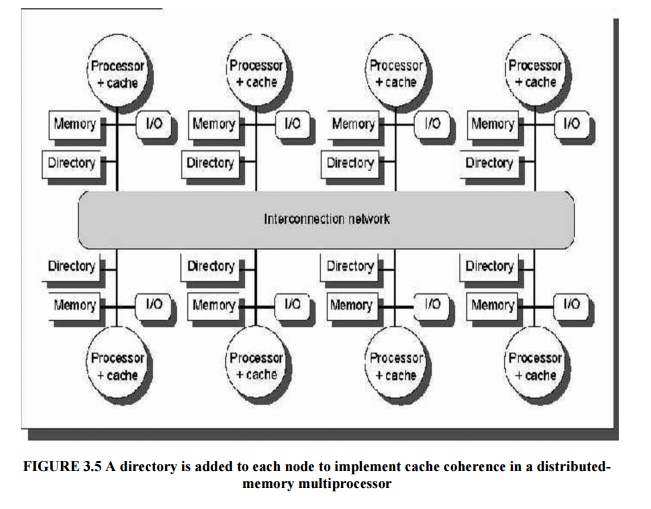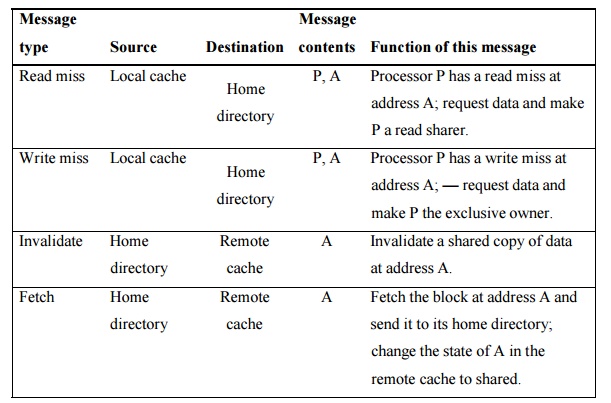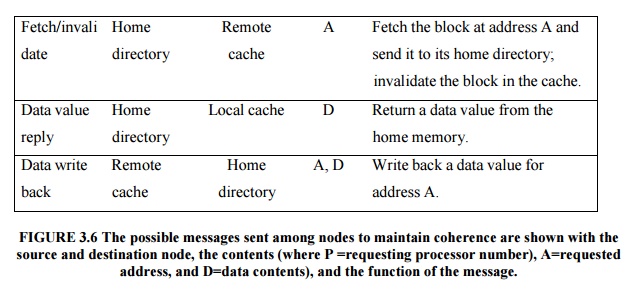Chapter: Advanced Computer Architecture : Multiprocessors and Thread Level Parallelism
Distributed Shared-Memory Architectures
Distributed Shared-Memory
Architectures.
There are
several disadvantages in Symmetric Shared Memory architectures.
Ø First,
compiler mechanisms for transparent software cache coherence are very limited.
Ø Second,
without cache coherence, the multiprocessor loses the advantage of being able
to fetch and use multiple words in a single cache block for close to the cost
of fetching one word.
Ø Third,
mechanisms for tolerating latency such as prefetch are more useful when they
can fetch multiple words, such as a cache block, and where the fetched data
remain coherent; we will examine this advantage in more detail later.
These
disadvantages are magnified by the large latency of access to remote memory
versus a local cache. For these reasons, cache coherence is an accepted
requirement in small-scale multiprocessors.
For
larger-scale architectures, there are new challenges to extending the
cache-coherent shared-memory model. Although the bus can certainly be replaced with
a more scalable interconnection network and we could certainly distribute the
memory so that the memory bandwidth could also be scaled, the lack of
scalability of the snooping coherence scheme needs to be addressed is known as
Distributed Shared Memory architecture.
The first
coherence protocol is known as a directory protocol. A directory keeps the
state of every block that may be cached. Information in the directory includes
which caches have copies of the block, whether it is dirty, and so on.
To prevent
the directory from becoming the bottleneck, directory entries can be
distributed along with the memory, so that different directory accesses can go
to different locations, just as different memory requests go to different
memories. A distributed directory retains the characteristic that the sharing
status of a block is always in a single known location. This property is what
allows the coherence protocol to avoid broadcast.
Figure
3.5 shows how our distributed-memory multiprocessor looks with the directories
Added to
each node.

Directory-Based
Cache-Coherence Protocols: The Basics
There are
two primary operations that a directory protocol must implement:
Ø handling
a read miss and handling a write to a shared, clean cache block. (Handling a
write miss to a shared block is a simple combination of these two.)
Ø To
implement these operations, a directory must track the state of each cache
block.
In a
simple protocol, these states could be the following:
Ø Shared—One
or more processors have the block cached, and the value in memory is up to date
(as well as in all the caches)
Ø Uncached—No
processor has a copy of the cache block
Exclusive—Exactly
one processor has a copy of the cache block and it has written the block, so
the memory copy is out of date. The processor is called the owner of the block.
In addition to tracking the state of each cache
block, we must track the processors that have copies of the block when it is
shared, since they will need to be invalidated on a write.
The simplest way to do this is to keep a bit vector
for each memory block. When the block is shared, each bit of the vector
indicates whether the corresponding processor has a copy of that block. We can
also use the bit vector to keep track of the owner of the block when the block
is in the exclusive state. For efficiency reasons, we also track the state of
each cache block at the individual caches.
A catalog of the message types that may be sent
between the processors and t he directories. Figure 6.28 shows the type of
messages sent among nodes. The local node is the node where a request
originates.
The home node is the node where the memory location
and the directory entry of an address reside. The physical address space is
statically distributed, so the node that contains the memory and directory for
a given physical address is known.
For example, the high-order bits may provide the
node number, while the low-order bits provide the offset within the memory on
that node. The local node may also be the home node. The directory must be
accessed when the home node is the local node, since copies may exist in yet a
third node, called a remote node.
A remote
node is the node that has a copy of a cache block, whether exclusive (in which
case it is the only copy) or shared. A remote node may be the same as either
the local node or the home node. In such cases, the basic protocol does not
change, but interprocessor messages may be replaced with intraprocessor
messages.


Related Topics